语言学选择题
- 格式:doc
- 大小:109.50 KB
- 文档页数:11
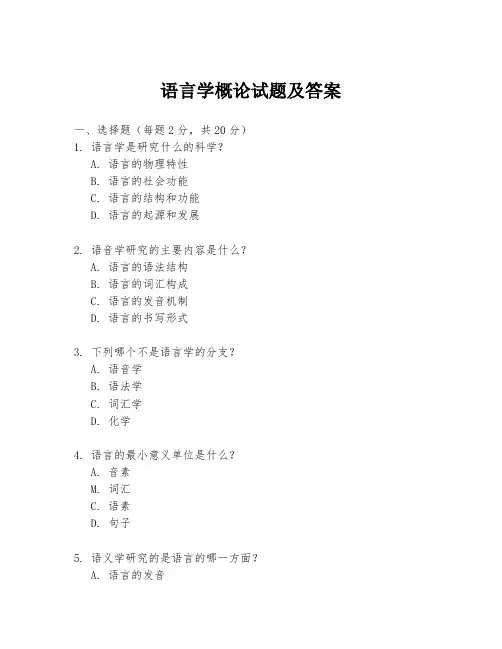
语言学概论试题及答案一、选择题(每题2分,共20分)1. 语言学是研究什么的科学?A. 语言的物理特性B. 语言的社会功能C. 语言的结构和功能D. 语言的起源和发展2. 语音学研究的主要内容是什么?A. 语言的语法结构B. 语言的词汇构成C. 语言的发音机制D. 语言的书写形式3. 下列哪个不是语言学的分支?A. 语音学B. 语法学C. 词汇学D. 化学4. 语言的最小意义单位是什么?A. 音素M. 词汇C. 语素D. 句子5. 语义学研究的是语言的哪一方面?A. 语言的发音B. 语言的意义C. 语言的书写D. 语言的语法6. 语言的词汇量是如何增长的?A. 通过新词的创造B. 通过旧词的淘汰C. 通过语言的混合D. 通过语言的简化7. 什么是语言的方言?A. 一种语言的书面形式B. 一种语言的口头形式C. 一种语言的地区变体D. 一种语言的官方标准8. 语言的同化现象是指什么?A. 语言的统一B. 语言的分化C. 语言的借用D. 语言的变异9. 语言的转换是指什么?A. 语言的翻译B. 语言的转写C. 语言的转述D. 语言的转换10. 什么是语言的语境?A. 语言的使用环境B. 语言的书写环境C. 语言的发音环境D. 语言的语法环境二、填空题(每题2分,共10分)11. 语言学的两大分支是________和________。
12. 语言的音位系统是由________构成的。
13. 语言的语法规则包括词法规则和________。
14. 语言的词汇化是指________转化为词汇的过程。
15. 语言的语用学研究的是语言在________中的使用。
三、简答题(每题10分,共20分)16. 简述语言的交际功能。
17. 简述语言的规范性与变异性。
四、论述题(每题15分,共30分)18. 论述语言与文化的关系。
19. 论述语言的演变过程及其影响因素。
五、案例分析题(每题20分,共20分)20. 请分析一种方言的形成过程,并讨论其对标准语的影响。
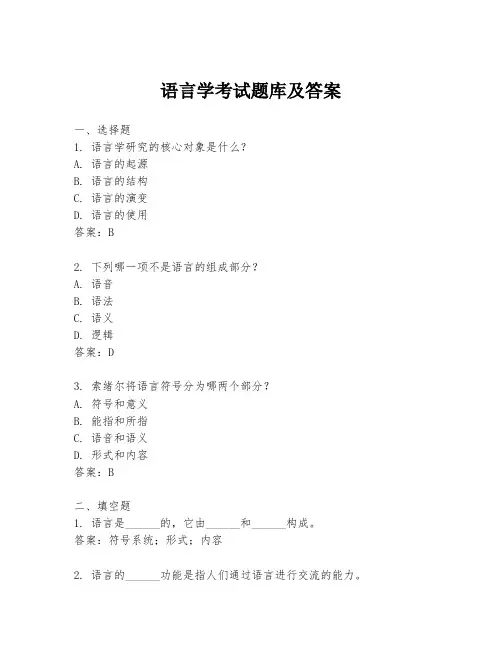
语言学考试题库及答案一、选择题1. 语言学研究的核心对象是什么?A. 语言的起源B. 语言的结构C. 语言的演变D. 语言的使用答案:B2. 下列哪一项不是语言的组成部分?A. 语音B. 语法C. 语义D. 逻辑答案:D3. 索绪尔将语言符号分为哪两个部分?A. 符号和意义B. 能指和所指C. 语音和语义D. 形式和内容答案:B二、填空题1. 语言是______的,它由______和______构成。
答案:符号系统;形式;内容2. 语言的______功能是指人们通过语言进行交流的能力。
答案:交流3. 语言的______功能是指语言能够表达思想和情感的能力。
答案:表达三、简答题1. 简述语言和言语的区别。
答案:语言是指一种抽象的符号系统,它包括语音、语法、语义等规则和结构;言语则是指个人使用语言进行交流的具体行为。
2. 描述索绪尔的“能指”和“所指”概念。
答案:索绪尔认为语言符号由“能指”和“所指”两部分组成。
“能指”指的是语言符号的声音形式,而“所指”指的是符号所代表的概念或意义。
四、论述题1. 论述语言的任意性原则及其对语言学习和教学的影响。
答案:语言的任意性原则指的是语言符号的声音形式和它所代表的概念之间没有必然的联系。
这一原则对语言学习和教学有着深远的影响,因为它意味着学习者需要记忆每个符号的声音和意义之间的联系,而不能依赖于逻辑或直观的关联。
这对语言教学提出了挑战,要求教师设计有效的教学方法来帮助学生记忆和理解这些任意的联系。
2. 分析语言的交际功能及其在现代社会中的重要性。
答案:语言的交际功能是指语言作为交流工具,使人们能够传递信息、表达情感和进行社会互动。
在现代社会,随着全球化和信息技术的发展,语言的交际功能变得尤为重要。
有效的沟通能够促进国际合作、文化交流和商业交易,同时也有助于解决社会冲突和增进理解。
因此,掌握一门或多门语言对于个人和社会的发展至关重要。
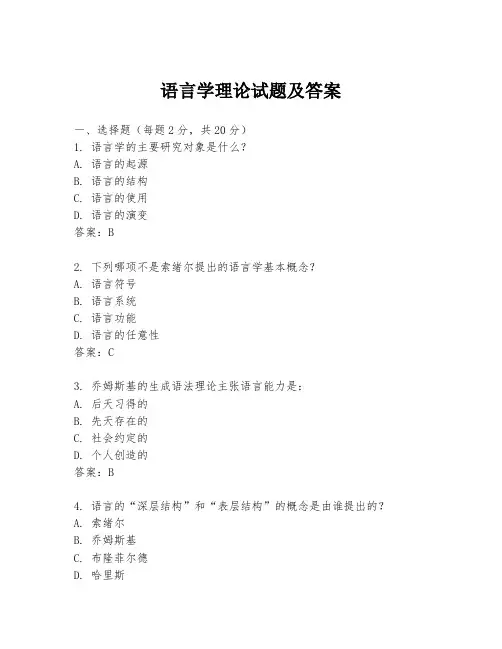
语言学理论试题及答案一、选择题(每题2分,共20分)1. 语言学的主要研究对象是什么?A. 语言的起源B. 语言的结构C. 语言的使用D. 语言的演变答案:B2. 下列哪项不是索绪尔提出的语言学基本概念?A. 语言符号B. 语言系统C. 语言功能D. 语言的任意性答案:C3. 乔姆斯基的生成语法理论主张语言能力是:A. 后天习得的B. 先天存在的C. 社会约定的D. 个人创造的答案:B4. 语言的“深层结构”和“表层结构”的概念是由谁提出的?A. 索绪尔B. 乔姆斯基C. 布隆菲尔德D. 哈里斯答案:B5. 语言的“同义异构”现象是指:A. 同一意义的不同表达方式B. 不同意义的相同表达方式C. 同一表达方式的不同意义D. 不同表达方式的相同意义答案:A6. 语言的“语境”指的是:A. 语言的内部结构B. 语言的外部环境C. 语言的使用者D. 语言的规则答案:B7. 语言的“语域”通常指的是:A. 语言的地域分布B. 语言的交际场合C. 语言的历史发展D. 语言的语法规则答案:B8. 语言的“语用学”研究的是:A. 语言的发音B. 语言的意义C. 语言的用法D. 语言的演变答案:C9. 语言的“语料库”是指:A. 语言的数据库B. 语言的规则集C. 语言的样本集D. 语言的词汇表答案:C10. 语言的“方言”是指:A. 同一语言的不同变体B. 不同语言的相似形式C. 同一语言的相同形式D. 不同语言的相同变体答案:A二、填空题(每题2分,共20分)1. 语言学的四大分支包括语音学、语法学、语义学和______。
答案:语用学2. 语言的“能指”指的是语言符号的______部分,而“所指”指的是语言符号的______部分。
答案:形式;意义3. 语言的“同音词”是指发音相同但______不同的词。
答案:意义4. 语言的“词缀”是指可以附加在词根上的______或______。
答案:前缀;后缀5. 语言的“句法”研究的是词、短语和句子的______。
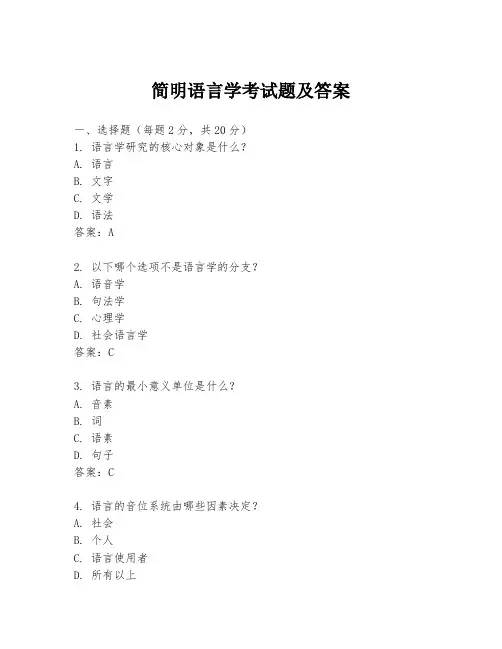
简明语言学考试题及答案一、选择题(每题2分,共20分)1. 语言学研究的核心对象是什么?A. 语言B. 文字C. 文学D. 语法答案:A2. 以下哪个选项不是语言学的分支?A. 语音学B. 句法学C. 心理学D. 社会语言学答案:C3. 语言的最小意义单位是什么?A. 音素B. 词C. 语素D. 句子答案:C4. 语言的音位系统由哪些因素决定?A. 社会B. 个人C. 语言使用者D. 所有以上答案:D5. 以下哪个术语是描述语言变化的?A. 语言演变B. 语言习得C. 语言接触D. 语言死亡答案:A6. 什么是方言?A. 一种语言的变体B. 一种语言的书面形式C. 一种语言的口语形式D. 一种语言的古语形式答案:A7. 以下哪个选项是语言的词汇特征?A. 语法性B. 音韵性C. 语义性D. 语音性答案:C8. 语言的语法结构包括哪些部分?A. 词法和句法B. 语音和语义C. 语素和词D. 词汇和语法答案:A9. 以下哪个选项是语言的交际功能?A. 信息传递B. 娱乐C. 教育D. 所有以上答案:D10. 什么是语言的规范性?A. 语言的规则性B. 语言的变异性C. 语言的随意性D. 语言的稳定性答案:A二、填空题(每题2分,共20分)1. 语言学研究的两个主要分支是______和______。
答案:理论语言学;应用语言学2. 语言学的四个基本子领域包括语音学、语法学、______和______。
答案:语义学;语用学3. 语言的最小音义结合体是______。
答案:词4. 语言的音位系统是由______决定的。
答案:语言的使用者5. 语言的演变过程包括语言的______、______和______。
答案:分化;传播;融合6. 方言是语言的______。
答案:变体7. 语言的词汇特征包括______、______和______。
答案:语法性;语义性;语音性8. 语言的语法结构由______和______组成。
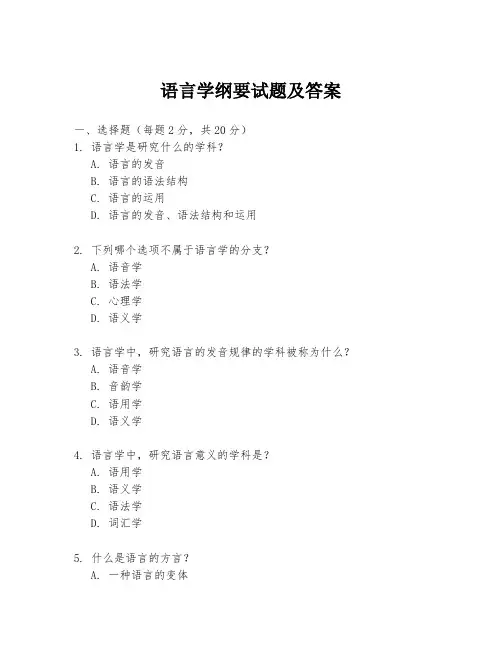
语言学纲要试题及答案一、选择题(每题2分,共20分)1. 语言学是研究什么的学科?A. 语言的发音B. 语言的语法结构C. 语言的运用D. 语言的发音、语法结构和运用2. 下列哪个选项不属于语言学的分支?A. 语音学B. 语法学C. 心理学D. 语义学3. 语言学中,研究语言的发音规律的学科被称为什么?A. 语音学B. 音韵学C. 语用学D. 语义学4. 语言学中,研究语言意义的学科是?A. 语用学B. 语义学C. 语法学D. 词汇学5. 什么是语言的方言?A. 一种语言的变体B. 一种完全不同的语言C. 一种语言的书面形式D. 一种语言的口头形式6. 语言学中,研究语言随时间变化的学科被称为什么?A. 历史语言学B. 社会语言学C. 比较语言学D. 结构语言学7. 下列哪个选项是研究语言与社会之间的关系的学科?A. 社会语言学B. 心理语言学C. 计算语言学D. 应用语言学8. 语言学中,研究语言如何被用来达到交际目的的学科是?A. 语用学B. 语义学C. 语法学D. 语音学9. 什么是语言的同源词?A. 来自不同语言的词B. 来自同一语言的词C. 来自同一词根的词D. 来自同一语言家族的词10. 语言学中,研究语言结构的学科被称为什么?A. 结构语言学B. 语音学C. 语义学D. 语用学答案:1-5 D C A A A 6-10 A A A C A二、填空题(每题2分,共10分)1. 语言学的四大分支包括语音学、语法学、语义学和______。
答案:语用学2. 语言学研究的两个主要领域是______和______。
答案:理论语言学;应用语言学3. 语言的方言是指在某一特定地区或社会群体中使用的______。
答案:语言变体4. 语言学中,研究语言随时间变化的学科是______。
答案:历史语言学5. 语言学中,研究语言与社会之间的关系的学科是______。
答案:社会语言学三、简答题(每题10分,共20分)1. 请简述语言学的主要研究内容。
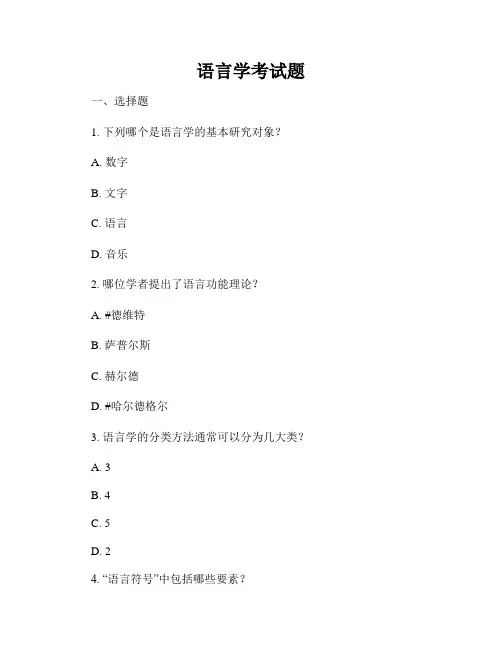
语言学考试题一、选择题1. 下列哪个是语言学的基本研究对象?A. 数字B. 文字C. 语言D. 音乐2. 哪位学者提出了语言功能理论?A. #德维特B. 萨普尔斯C. 赫尔德D. #哈尔德格尔3. 语言学的分类方法通常可以分为几大类?A. 3B. 4C. 5D. 24. “语言符号”中包括哪些要素?A. 声音B. 符号C. 拼写D. A、B5. 在语法范畴中,“动宾关系”是指什么?A. 主语和谓语之间的语法关系B. 主语和宾语之间的语法关系C. 宾语和谓语之间的语法关系D. 主语和动词之间的语法关系二、填空题6. 语言学中研究音素的学科是---。
7. 没有逻辑意义的音节称为---。
8. 语音学的基本单位是---。
9. 下列哪个不是语言学的分支学科?10. 一种语言中声母、韵母和声调三者综合的组合称为---。
三、简答题11. 请简要说明音韵学和语音学的区别。
12. 什么是“方言”,方言和语言的关系是什么?13. 什么是语法,语法的作用是什么?14. “文字和语言的关系”是语言学中一个重要问题,请简述你对这个问题的理解。
15. 请简要介绍语言学的研究方法有哪些?四、论述题16. 语言是人类最重要的交流工具之一,请说明语言对个体和社会的重要性。
17. 语言学的发展历程是怎样的?过去、现在和未来的语言学会有怎样的发展趋势?18. 请解释语言与文化之间的关系,并谈谈语言多样性对世界文化的重要影响。
以上便是本次语言学考试题的全部内容,请同学们认真地完成每一道题目,祝大家取得优异的成绩!。
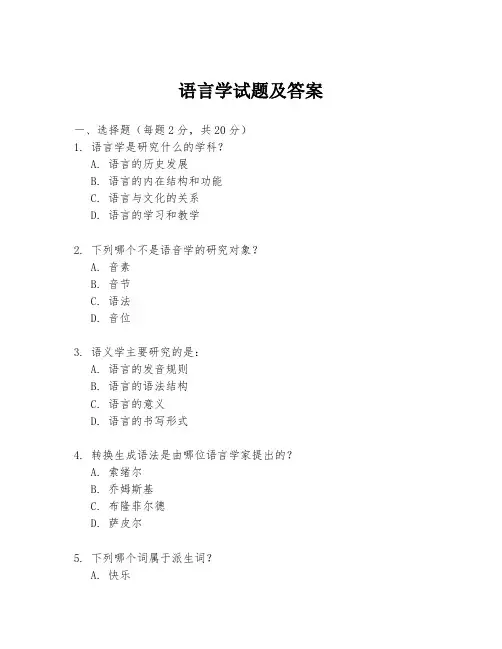
语言学试题及答案一、选择题(每题2分,共20分)1. 语言学是研究什么的学科?A. 语言的历史发展B. 语言的内在结构和功能C. 语言与文化的关系D. 语言的学习和教学2. 下列哪个不是语音学的研究对象?A. 音素B. 音节C. 语法D. 音位3. 语义学主要研究的是:A. 语言的发音规则B. 语言的语法结构C. 语言的意义D. 语言的书写形式4. 转换生成语法是由哪位语言学家提出的?A. 索绪尔B. 乔姆斯基C. 布隆菲尔德D. 萨皮尔5. 下列哪个词属于派生词?A. 快乐B. 快速C. 快乐地D. 快车6. 句法学研究的是:A. 句子的构成B. 词义的组合C. 语言的发音D. 语言的书写7. 社会语言学关注的是:A. 语言的变异与变化B. 语言与社会的关系C. 语言的起源和发展D. 语言的标准化8. 语言的功能主义理论是由下列哪位语言学家提出的?A. 索绪尔B. 乔姆斯基C. 韩礼德D. 布隆菲尔德9. 语言的同源词是指:A. 同一种语言中的不同词B. 不同语言中意义相同的词C. 来自同一词根的词D. 不同语言中发音相同的词10. 下列哪项不是语用学的研究内容?A. 语境B. 言语行为C. 语言的逻辑结构D. 语言的交际功能答案:1-5 B C C B D 6-10 A C B C C二、填空题(每题1分,共10分)1. 语言学的四个主要分支是语音学、语法学、语义学和________。
2. 索绪尔是________语言学的创始人。
3. 语言的任意性原则是指语言符号的_______和_______之间没有必然的联系。
4. 词类转换是指通过改变词的形式来改变其_______。
5. 语言的同化现象是指不同语言在交流中逐渐_______的现象。
6. 语言的方言是指同一语言内部由于_______、_______等因素而形成的不同变体。
7. 语言的借词是指一种语言从另一种语言中借用的_______或_______。
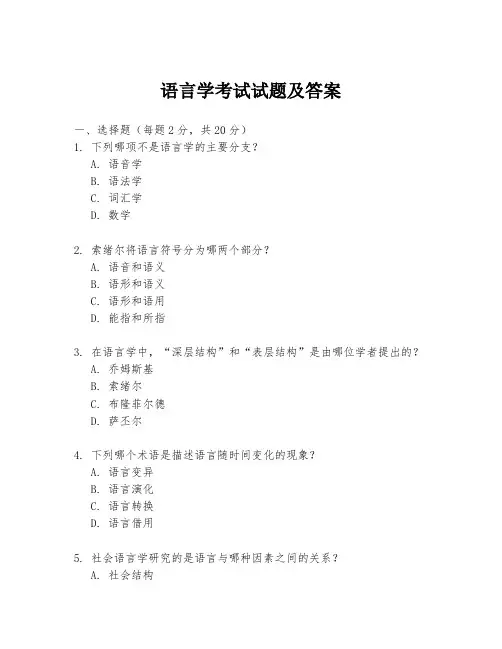
语言学考试试题及答案一、选择题(每题2分,共20分)1. 下列哪项不是语言学的主要分支?A. 语音学B. 语法学C. 词汇学D. 数学2. 索绪尔将语言符号分为哪两个部分?A. 语音和语义B. 语形和语义C. 语形和语用D. 能指和所指3. 在语言学中,“深层结构”和“表层结构”是由哪位学者提出的?A. 乔姆斯基B. 索绪尔C. 布隆菲尔德D. 萨丕尔4. 下列哪个术语是描述语言随时间变化的现象?A. 语言变异B. 语言演化C. 语言转换D. 语言借用5. 社会语言学研究的是语言与哪种因素之间的关系?A. 社会结构B. 文化传统C. 个人心理D. 经济发展6. 哪种语言现象是指在特定情境下,说话者选择不同语言或语言变体的能力?A. 语码转换B. 语码混用C. 语用学D. 语言礼貌7. 下列哪项不是语用学的研究内容?A. 言语行为B. 隐喻理解C. 语言礼貌D. 语言的生物学基础8. 什么是“双重否定”?A. 使用两个否定词来表达否定意义B. 使用两个否定词来表达肯定意义C. 使用一个否定词来表达否定意义D. 使用一个否定词来表达肯定意义9. 在语言学中,“同音词”是指什么?A. 意义相同但拼写不同的词B. 拼写相同但意义不同的词C. 发音相同但意义不同的词D. 发音和意义都相同的词10. 下列哪项是“语言接触”的一个例子?A. 语言的地理分布B. 语言的独立发展C. 语言的借用和融合D. 语言的孤立使用二、填空题(每题2分,共20分)11. 语言学中的“_______”是指研究语言的结构特征,不涉及语言的社会功能。
答案:形式语言学12. 转换生成语法是由_______提出的,它强调语言的生成能力。
答案:诺姆·乔姆斯基13. “Hello”一词在不同的语境中可以有不同的功能,这属于_______的研究范畴。
答案:语用学14. 社会语言学中的“_______”是指语言随社会因素(如年龄、性别、社会阶层等)而变化的现象。
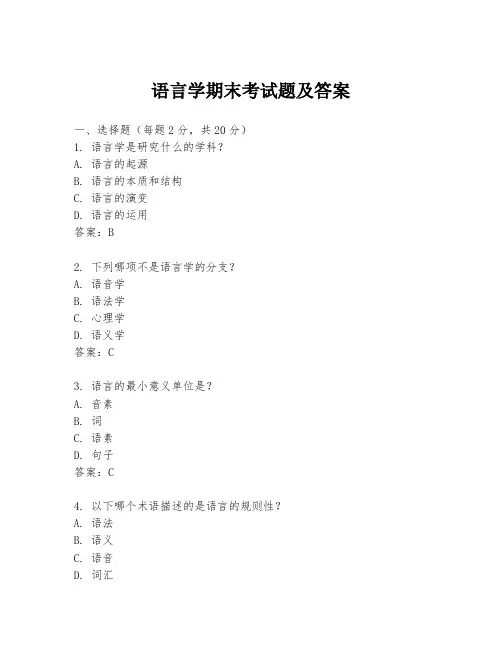
语言学期末考试题及答案一、选择题(每题2分,共20分)1. 语言学是研究什么的学科?A. 语言的起源B. 语言的本质和结构C. 语言的演变D. 语言的运用答案:B2. 下列哪项不是语言学的分支?A. 语音学B. 语法学C. 心理学D. 语义学答案:C3. 语言的最小意义单位是?A. 音素B. 词C. 语素D. 句子答案:C4. 以下哪个术语描述的是语言的规则性?A. 语法B. 语义C. 语音D. 词汇5. 语言的交际功能指的是什么?A. 语言的内部结构B. 语言的外部形式C. 语言的社会功能D. 语言的个人表达答案:C6. 语言的哪一部分负责表达概念?A. 语音B. 语法C. 语义D. 词汇答案:C7. 下列哪项是语言的物理表现形式?A. 语法B. 语义C. 语音D. 语用答案:C8. 语言的哪一部分负责表达关系?A. 语法B. 语义C. 语音D. 词汇答案:A9. 语言的哪一部分负责表达情感?B. 语用C. 语音D. 词汇答案:B10. 以下哪个术语描述的是语言的变异?A. 语言变异B. 语言变化C. 语言演化D. 语言发展答案:A二、填空题(每空1分,共20分)1. 语言学的主要研究对象是______。
答案:语言2. 语言的三个基本功能包括表达、______和交际。
答案:指称3. 语音学研究的是语言的______方面。
答案:声音4. 语法学研究的是语言的______方面。
答案:结构5. 语义学研究的是语言的______方面。
答案:意义6. 词汇学研究的是语言的______方面。
答案:词汇7. 语用学研究的是语言的______方面。
答案:使用8. 语言的最小意义单位是______。
答案:语素9. 语言的最小声音单位是______。
答案:音素10. 语言的最小结构单位是______。
答案:词三、简答题(每题10分,共40分)1. 请简述语言学的主要研究内容。
答案:语言学主要研究语言的本质、结构、发展、变化以及语言在社会和个人中的作用。
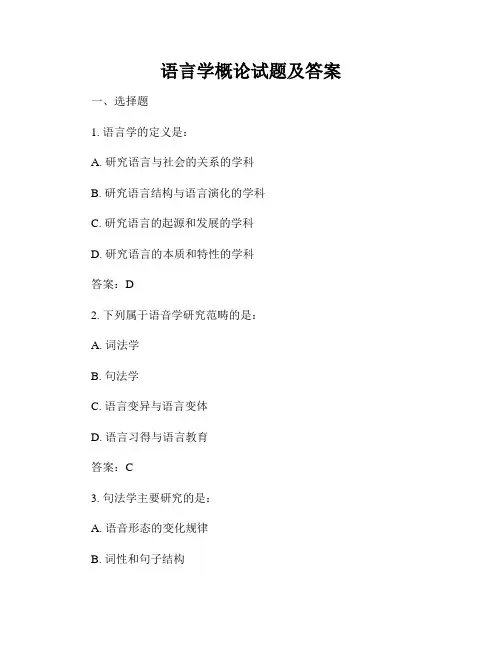
语言学概论试题及答案一、选择题1. 语言学的定义是:A. 研究语言与社会的关系的学科B. 研究语言结构与语言演化的学科C. 研究语言的起源和发展的学科D. 研究语言的本质和特性的学科答案:D2. 下列属于语音学研究范畴的是:A. 词法学B. 句法学C. 语言变异与语言变体D. 语言习得与语言教育答案:C3. 句法学主要研究的是:A. 语音形态的变化规律B. 词性和句子结构C. 语音的音位和音位组合D. 语义和语用规则答案:B4. 下列关于语言习得的描述,错误的是:A. 语言习得是指儿童在自然环境中习得母语的过程B. 成年人可以通过学习掌握一门新的语言C. 语言习得是通过语言输入和输出实现的D. 语言习得是一个渐进的、自然而然的过程答案:C5. 下列属于语用学研究范畴的是:A. 语音学B. 句法学C. 话语分析D. 语言变异与语言变体答案:C二、简答题1. 什么是语音学?答:语音学是研究语言中的语音系统和语音形态的学科,主要关注语音的音位和音位组合规律,以及语音变体和语音变异等现象。
2. 什么是语法?答:语法是研究语言结构和语法规则的学科,包括词法学和句法学。
词法学研究词汇和词的构词法规律,句法学研究句子的构建和句法规则。
3. 什么是语义学?答:语义学是研究语言意义的学科,主要关注词义、句义和上下文语境对语言意义的影响。
研究对象包括词汇的意义、句子的意义以及语义关系等。
4. 什么是语用学?答:语用学是研究语言使用和交际的学科,主要关注语言在实际交际中的运用和语用规则。
研究对象包括语音、语法、语义在特定语境下的意义解释和语用前提等。
三、论述题语言学是一门跨学科的学科,涉及到多个子学科的研究内容和方法。
在语言学的研究中,语音学、语法学、语义学以及语用学是其中最为核心的四个分支。
语音学是研究语音系统的学科,主要研究语音的音位和音位组合规律,以及语音变体和语音变异等现象。
通过语音学的研究,我们能够了解不同语言中的语音系统差异,以及语音变体对语义和语用的影响。
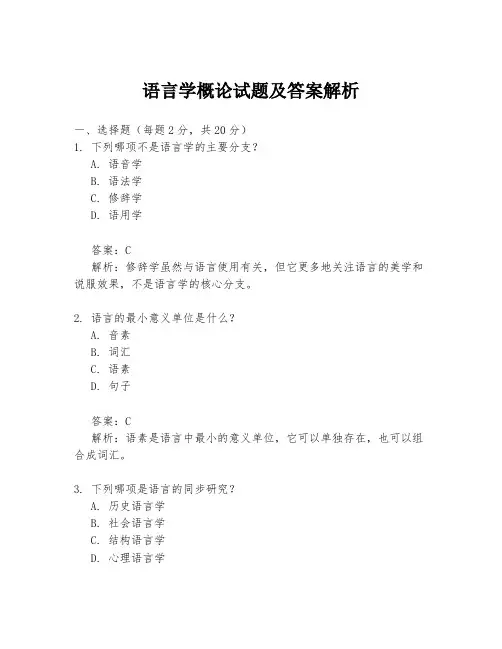
语言学概论试题及答案解析一、选择题(每题2分,共20分)1. 下列哪项不是语言学的主要分支?A. 语音学B. 语法学C. 修辞学D. 语用学答案:C解析:修辞学虽然与语言使用有关,但它更多地关注语言的美学和说服效果,不是语言学的核心分支。
2. 语言的最小意义单位是什么?A. 音素B. 词汇C. 语素D. 句子答案:C解析:语素是语言中最小的意义单位,它可以单独存在,也可以组合成词汇。
3. 下列哪项是语言的同步研究?A. 历史语言学B. 社会语言学C. 结构语言学D. 心理语言学答案:C解析:结构语言学关注的是特定时间点上语言的结构,是语言的同步研究。
4. 语言的任意性原则是由哪位学者提出的?A. 索绪尔B. 乔姆斯基C. 布隆菲尔德D. 弗洛伊德答案:A解析:索绪尔是现代语言学的奠基人,他提出了语言的任意性原则,即语言符号的形式与其指代的对象之间没有必然的逻辑关系。
5. 下列哪项不是语言的功能?A. 信息传递B. 情感表达C. 社会认同D. 艺术创作答案:D解析:虽然语言可以用于艺术创作,但它本身不是一种艺术形式,因此不是语言的基本功能。
二、填空题(每题2分,共20分)6. 语言学研究的对象是________。
答案:人类语言7. 语音学研究的是语音的________和________。
答案:产生、传递、感知8. 转换生成语法是由________提出的。
答案:诺姆·乔姆斯基9. 在语言的词汇-语法参数中,________是指语言中词汇和语法的关系。
答案:词汇-语法参数10. 社会语言学研究的是语言与________之间的关系。
答案:社会三、简答题(每题10分,共30分)11. 简述语言的创造性特点。
答案:语言的创造性体现在用户能够使用有限的词汇和语法规则生成无限多的句子。
这种能力源于语言的组合性质,即通过不同的词汇和语法结构的组合,创造出新的句子和表达。
12. 解释什么是“深层结构”和“表层结构”。
语言学的考试试题一、选择题(每题2分,共20分)1. 下列哪项不是语言学的分支学科?A. 语音学B. 语法学C. 心理学D. 语义学2. 语言学中的“音素”是指:A. 语言中最小的意义单位B. 语言中最小的音位单位C. 语言中的词汇D. 语言中的语法规则3. 在语言学中,“词汇-功能语法”是由哪位学者提出的?A. Noam ChomskyB. Ronald LangackerC. HallidayD. Edward Sapir4. 下列哪个选项是“双语现象”的正确描述?A. 一个人能够使用两种语言B. 一个地区存在两种官方语言C. 一个人同时学习两种语言D. 一个国家有两种语言的使用者5. “转换生成语法”是由哪位语言学家提出的?A. Ferdinand de SaussureB. Noam ChomskyC. Leonard BloomfieldD. Wilhelm Wundt6. 语言学中的“同音异义词”指的是:A. 发音相同但意义不同的词B. 意义相同但发音不同的词C. 发音和意义都相同的词D. 发音和意义都不同的词7. 下列哪项不是社会语言学研究的内容?A. 语言与社会的关系B. 语言的变迁C. 语言在不同社会群体中的使用D. 语言的生物学基础8. “语言习得”通常指的是:A. 学习第二语言B. 儿童学习母语的过程C. 成人学习外语D. 语言的演变过程9. 下列哪个选项不是语用学的研究范畴?A. 语境对语言使用的影响B. 语言的交际功能C. 语言的内部结构D. 语言的理解和解释10. “语言的任意性”这一概念是由哪位语言学家提出的?A. Charles OgdenB. Thomas HobbesC. Ferdinand de SaussureD. William of Ockham二、填空题(每题2分,共20分)11. 语言学中的“_______”指的是语言的声音和书写形式之间的关系。
12. “_______”是指语言中最小的、有意义的音段,是构成词汇的基本单位。
语言学考试试题及答案一、选择题(每题2分,共20分)1. 语言学是研究语言的科学,它包括以下哪些分支学科?A. 语音学B. 语法学C. 语义学D. 所有选项答案:D2. 下列哪个术语不是语言学的分支?A. 社会语言学B. 心理语言学C. 神经语言学D. 化学语言学答案:D3. 语言的最小意义单位是什么?A. 音素B. 词素C. 词D. 句子答案:B4. 以下哪个选项是语言的语音属性?A. 音高B. 音长C. 音色D. 所有选项答案:D5. 语言的语法规则可以是:A. 显性的B. 隐性的C. 两者都是D. 两者都不是答案:C6. 以下哪种语言现象不属于语言变异?A. 方言B. 社会方言C. 语言接触D. 语言消亡答案:D7. 语言的演变通常被认为是:A. 随机的B. 有目的的C. 无意识的D. 有意识的答案:C8. 语言接触可能导致:A. 语言融合B. 语言分离C. 语言借用D. 所有选项答案:D9. 语言的语用学研究的是:A. 语言的语境B. 语言的功能C. 语言的意义D. 所有选项答案:D10. 以下哪个术语不属于语义学研究的范围?A. 语义场B. 语义角色C. 语义关系D. 音位学答案:D二、填空题(每题2分,共20分)1. 语言的______属性包括音高、音长和音色。
答案:语音2. 语言的______属性包括语法、词汇和语义。
答案:结构3. 语言的______属性涉及语言的社会和文化方面。
答案:社会4. 语言学中的______理论认为语言是一系列规则的集合。
答案:形式主义5. 语言的______是语言学研究的基础单位。
答案:句子6. 语言的______是指语言在不同社会群体中的变体。
答案:变异7. 语言的______是指语言在不同地理区域的变体。
答案:方言8. 语言的______是指语言在不同时间的演变。
答案:历史9. 语言的______是指语言在不同语境中的使用。
答案:语用10. 语言的______是指语言的抽象意义。
语言学概要试题及答案一、选择题(每题2分,共20分)1. 语言学研究的主要对象是什么?A. 语言B. 文学C. 历史D. 哲学答案:A2. 以下哪一项不是语言学的分支?A. 语音学B. 句法学C. 心理学D. 社会语言学答案:C3. 语言的最小意义单位是什么?A. 音素B. 词C. 语素D. 句子答案:C4. 以下哪种语言是孤立语言?A. 英语B. 汉语C. 法语D. 德语5. 语言的三大功能是什么?A. 表达、交流、记录B. 描述、命令、询问C. 表达、交流、思考D. 描述、命令、表达答案:C6. 以下哪个概念不属于语用学研究范畴?A. 语境B. 隐喻C. 语调D. 语言礼貌答案:B7. 语言的共时性研究主要关注什么?A. 语言的历史发展B. 语言的地理分布C. 语言的内部结构D. 语言的社会功能答案:C8. 以下哪个术语是描述语言的语音特征?A. 语义B. 语用C. 音位D. 语法答案:C9. 以下哪种语言属于印欧语系?B. 英语C. 日语D. 韩语答案:B10. 语言的演变过程称为什么?A. 语言发展B. 语言变化C. 语言进化D. 语言革新答案:B二、填空题(每题2分,共20分)1. 语言学的创始人是______。
答案:费迪南·德·索绪尔2. 语言的词汇、语法和语音三个部分构成了语言的______。
答案:形式结构3. 语言的______性指的是语言能够表达思想和情感。
答案:表达4. 语言的______性指的是语言能够传达信息。
答案:交流5. 语言的______性指的是语言能够影响思维。
答案:思考6. 语言学研究的一个主要方法是______。
答案:观察7. 语言的______指的是语言的规则性。
答案:系统8. 语言的______指的是语言的多样性。
答案:变异9. 语言的______指的是语言的稳定性。
答案:连续10. 语言的______指的是语言的可变性。
答案:变化三、简答题(每题10分,共30分)1. 请简述语言学的主要研究方法。
现代语言学试题及答案一、选择题(每题2分,共20分)1. 现代语言学研究的核心是什么?A. 语言的起源B. 语言的演变C. 语言的规则D. 语言的功能答案:C2. 以下哪项不是语言学的分支?A. 语音学B. 语法学C. 心理学D. 语义学答案:C3. 语言学中的“phoneme”指的是什么?A. 音位B. 音素C. 音节D. 音标答案:A4. 下列哪个选项是“语言接触”的结果?A. 语言的消亡B. 语言的产生C. 语言的融合D. 语言的孤立答案:C5. 以下哪种语言现象不属于词汇变化?A. 合成B. 派生C. 借用D. 语音变化答案:D6. 语言学中的“transformational grammar”是什么?A. 转换语法B. 句法分析C. 语义分析D. 语音学答案:A7. 以下哪个术语与语言的“社会功能”无关?A. 语言的规范B. 语言的变异C. 语言的习得D. 语言的交际答案:C8. “语言的普遍语法”是哪位语言学家提出的?A. 费尔迪南·德·索绪尔B. 诺姆·乔姆斯基C. 爱德华·萨丕尔D. 威廉·冯·洪堡特答案:B9. 以下哪种语言现象不属于语用学研究范畴?A. 言语行为B. 语境分析C. 语音变化D. 隐喻答案:C10. “语言的相对性原则”是哪种语言理论的核心?A. 结构主义B. 形式主义C. 功能主义D. 心理语言学答案:A二、填空题(每题2分,共20分)1. 语言学的创始人是________。
答案:费尔迪南·德·索绪尔2. 语言学中,________是指语言的最小意义单位。
答案:语素3. 语言的________是指语言在特定社会环境中的使用。
答案:语境4. 语言学中的________是指语言的音韵结构。
答案:音韵学5. 语言的________是指语言的词汇和语法结构。
答案:形式6. 语言学中的________是指语言的规则系统。
语言学1.__A__ is the study of speech sounds in language or a language with reference to their distribution and patterning and to tacit rules governing pronunciation.A. PhonologyB. LexicographyC. LexicologyD. Morphology2. __C__ is defined as the scientific study of language, studying language in general.A. PsycholinguisticsB. NeurolinguisticsC. LinguisticsD. Phonetics3. Which of the linguistic items listed below is best described as the smallest unit of meaning? BA. the wordB. the morphemeC. the phonemeD. the clause4. A prefix is an affix which appears __B__.A. after the stemB. before the stemC. in the middle of the stemD. below the stem5. Which of the following is true? __C__A. Phonetics is the study of pronunciation.B. Phonetics is the scientific study of the movement of sound waves.C. Phonetics is the scientific study of the sounds of language.D. Phonetics is the scientific study of the organs of speech.6. “What’s in a name? That which we call a roseBy any other name would smell as sweetSo Romeo would, were he not Romeo called,” (Romeo and Juliet, Act 2, Scene 2, 43~5)To what characteristic of language dose Shakespeare refer? __D__A. CreativityB. ProductivityC. DualityD. Arbitrariness7. Language, as a system, consists of two sets of structures or two levels, which is known as __A__, one of a design features of human language.A. DualityB. DisplacementC. ProductivityD. Arbitrariness8. The different members of a phoneme, sounds which are phonetically different but do not make one word different from another in meaning, are __D__.A. phonemesB. phonesC. soundsD. allophones9. What is complementary distribution? __A__A. Different places of occurrence of allophones within a word.B. When a phone can only occur at the end of a word.C. When an allophone occurs at the beginning of a word.D. Contrastive distribution of allophones10. __D__ deals with the analysis and creation of words, idioms and collocations.A. MorphemeB. V ocabularyC. RootD. Lexicon1. Cold and hot are called __B__ antonyms.A. complementaryB. gradableC. reversalD. converse2. “I regret that I can’t help you.” This is an example of __C__.A. representativesB. directivesC. expressivesD. commissives3. What is the duality of the language? __D__A. Letters and soundsB. Sounds and symbolsC. Symbols and meaningD. sounds and meaning4. “I bought some roses” __A__ “I bought some flowers”.A. entailsB. presupposesC. is inconsistent withD. is synonymous with5. Of the following linguists, __C__ should be grouped into Prague School.A. BloomfieldB. SaussureC. JakobsonD. Firth6. Damage in and around the angular gyrus of the parietal lobe often causes the impairment of reading and writingability, which is often referred to as acquired __C__.A. diglossiaB. aphasiaC. dyslexiaD. dysgraphia7. __A__ A Dictionary of the English Language established a uniform standard for the spelling and word use.A. Samuel Johnson’sB. Bishop Lowth’sC. Firth’sD. Samuel John’s8. What is phonology? __B__A. The study of how speech sounds are made, transmitted and receivedB. The study of the function, behavior and organization of speech sounds as linguistic items.C. The study of the International Phonetic Alphabet.D. The study of all possible speech sounds.9. The morpheme “cast” in the common word “telecast” is a (n) __D__.A. bound morphemeB. bound formC. inflectional morphemeD. free morpheme10. A phoneme is __D__.A. a set of different realization of a phoneB. a set of contrastive allophones in free variationC. a set of phones in complementary distributionD. a set of phonetically similar noncontrastive phones1. Firstly, to which of these language groups dose English belong? __A__A. GermanicB. SlavonicC. romanceD. Baltic2. What is defined as “the study of sentence structure”? __D__A. MorphologyB. SemanticsC. PhonologyD. Syntax3. According to Krashen, __D__ refers to the gradual and subconscious development of ability in the first languageby using it naturally in daily communicative situations.A. learningB. competenceC. performanceD. acquisition4. There are different types of affixes or morphemes. The affix “ed” in the word “learned” is known as a(n) __C__.A. derivational morphemeB. free morphemeC. inflectional morphemeD. free form5. __C__ studies the total stock of morphemes of a language, especially those items which have clear semantic references.A. PhonologyB. LexicologyC. MorphologyD. Lexicography6. As a type of linguistic system in L2 learning, __A__ is a product of L2 training, mother tongue interference,overgeneralization of the target language rules, and learning and communicative strategies of the learner.A. interlanguageB. interferenceC. language transferD. linguistic relativity7. __A__ means the lack of a logical connection between the form of something and its expression in sounds.A. ArbitrarinessB. AbstractnessC. AmbiguityD. Fuzziness8. The term __B__ linguistics may be defined as a way of referring to the approach which studies language changeover various periods of time and at various historical stages.A. synchronicB. diachronicC. comparativeD. historical comparative9. When a speech sound changes and becomes more like another sound that follows or precedes it, it is said to be__D__.A. nasalizedB. voicedC. aspiratedD. assimilated10. F. de Saussure is a (n) __C__ linguist.A. AmericanB. BritishC. SwissD. Russian1. N. Chomsky is a (n) __A__ linguist.A. AmericanB. CanadaC. SwissD. French2. The Sapir-Whorf Hypothesis has two thrusts: __B__ and ____.A. Linguistic description, Linguistic determinismB. Linguistic determinism, Linguistic relativityC. Linguistic relativity, Linguistic descriptionD. Linguistic determinism, Linguistic performance3. A special language variety that mixes or blends languages and used by people who speak different language forrestricted purpose is __A__.A. pidiginB. creoleC. dialectD. blends4. By __B__, we refer to word forms which differ from each other only by one sound, e.g. “pin” and “bin”.A. complementally distributionB. minimal pairC. Adjacency pairD. code—switching5. When two sounds never occur in the same environment they said to be in __A__.A. complementary distributionB. free variationC. co-occurrenceD. minimal pair6. __D__ century is considered to be the beginning of Modern English.A. 18thB. 17thC. 19thD. 16th7. Conventionally a __B__ is put in slashes.A. allophoneB. phonemeC. phoneD. morpheme8. __D__ is a principle of scientific method, based on the belief that the only things valid enough to confirm orrefute o scientific theory are interpersonally observable phenomena, rather than people’s introspections or intuitions.A. MentalismB. Functional grammarC. Case grammarD. Behaviorism9. According to Searle, those illocutionary acts whose point is to commit the speaker to some future course ofaction are called __C__.A. expressivesB. directivesC. commisivesD. declaratives*10. A __C__ is often seen as part of a word, but it can never stand by itself although it bears clear, definite meaning.A. morphemeB. wordC. rootD. phoneme1. Linguistics is the scientific study of __C__.A. a particular languageB. the English languageC. human language in generalD. the system of a particular language2. __A__ is the language that a learner constructs at a given stage of SLA.A. InterlanguageB. IdeologyC. DialectD. Interference3. Phonological rules that govern the combination of sounds in a particular language are called __ B__ rule.A. DeletionB. SequentialC. superasegmentalD. Assimilation4. “There is no direct link between a linguistic form and what it refers to”. This is the __B__ view concerning the study of meaning.A. naming theoryB. conceptualistC. contextualistD. behaviorist5. English consonants can be classified into stops, fricatives, nasals, etc. , in terms of __A__.A. manner of articulationB. openness of mouthC. place of articulationD. voicing6. According to Chomsky, __A__ is the ideal user’s internalized knowledge of his language.A. competenceB. paroleC. performanceD. langue7. __A__ is not a suprasegmental feature.A. AspirationB. IntonationC. StressD. Tone8. __A__ is a phenomenon that L2 learners subconsciously use their L1language in their learning process.A. Language transferB. BlendingC. InterferenceD. Cooperative9. __C__ are affixes added to an existing form to create a new word, e.g. in-,-er.A. inflectional morphemeB. free morphemeC. derivational morphemeD. root10. Writing is the secondary language form based on __B__.A. soundB. speechC. gestureD. sign1. __C__ covers the study of language use in relation to context, and in particular the study of linguistic communication.A. SemanticsB. SociolinguisticsC. PragmaticsD. Linguistics2. Morphemes that represent “tense”, “number”, “gender”, “case” and so on are called __A__ morphemes.A. inflectionalB. freeC. boundD. derivational3. Which of the following is not a compound word? __C__A. clearwayB. rainbowC. scarcityD. without4. The fact that ability to speak a language is transmitted from generation to generation by process of learning, and not genetically is referred to as __A__.A. culture transmissionB. performanceC. competenceD. acquisition5. __C__ is the language of Angles, Saxons and Jutes who invaded Britain after AD 450.A. Old NorseB. CleticC. Old EnglishD. Middle English6. A group of two or more consonants together in a syllable is called a (n) __C__.A. arresting clusterB. releasing clusterC. consonant clusterD. syllable7. The semantic features of the word “woman” can be expressed as __C__.A. +ANIMATE, -- HUMAN, +ADULT, +MALEB. + ANIMATE, + HUMAN, -- ADULT, + MALEC. + ANIMATE, + HUMAN, + ADULT, -- MALED. + ANIMATE, -- HUMAN, -- ADULT, -- MALE8. __A__ is to refer to an auxiliary language used to enable routine communication to take place between groups of people who speak different native languages.A. Lingua francaB. DialectC. PidginD. Ethnic dialect9. __A__ is the study of the relationship between brain and language, including research into how the structure of the brain influences language learning.A. NeurolinguisticsB. PsyhcholingisticsC. Applied LinguisticsD. Sociolinguistics10. Modern synchronic linguistics traditionally dates from the __B__ of Swiss scholar Ferdinand de Saussure.A. Syntactic structureB. Cours de Linguitique GeneralC. De Lingua LatinaD. Language and Mind1.According to the strong version of the __A__ hypothesis, language determines speakers’ perceptions andpatterns their way of life.A. Sapir WhorfB. inputC. GrimD.Innateness2. Which of the following is true? __D__A. In the history of any language the writing system always came into being before the spoken form.B. A compound is the combination of only two words.C. The division of English into old English, Middle English, and Modern English is nonconventional and notarbitrary.D. If a child is deprived of linguistic environment, he or she is unlikely to learn a language successfully lateron.3. Which of the following statements is not true? __D__A. Language is a system of arbitrary vocal symbols used for human communication.B. Language is human specificC. Language is relatively stable and systematic while parole is subject to personal and situational constraintsD.The first language was invented by Adam, the first man.4. A group of people who do in fact have the opportunity to interact with each other and who share not just a single language with its related varieties but also attitudes to- ward linguistic norms are defined as __B__.A. speech varietyB. speech communityC. registerD. sociolect5. “Your money or your life?” is an example of __C__.A. representativeB. expressiveC. directivesmissives6. Which of the following distinctive features can be used to separate [p] and [b]? _D_A. stopB. fricativesC. bilabialD.voiced7. __D__ studies the total stock of morphemes of a language particularly those items which have clear semantic references.A. LexicographyB. PhonologyC. LexicologyD.Morphology8. __C__ theorized that acquisition of language is an innate process determined by biological factors which limit the important period for acquisition of a language from roughly two years of age to puberty.A. Input hypothesisB. Interaction hypothesisC. Critical period hypothesisD.Sapir-Whorf Hypothesis9. An example of __C__ would be the change in meaning undergone by the OE word, docga, modern day dog. In OE docga referred to a particular breed of dog, while in modern usage it refers to the class of dogs as a whole.A. semantic degradationsB. semantic reductionsC. semantic extensionsD. semantic elevation10. According to Chomsky, the child is born with a built – in set of rules, which have the specific function of enabling her to construct the grammar of her mother tongue. This view is to be seen as __C__.A. Input hypothesisB. X-theoryC. Language acquisition deviceD.Universal grammar1. “Old” and “Young” are a pair of __D__ opposites.A. complementaryB. relationalC. converseD. gradable2. Systemic-Functional Grammar, one of the most influential linguistic theories in the 20th century, is put forward by __B__.A. ChomskyB. HallidayC. FirthD.Malinowski3. V owels that are produced between the positions for a front and back vowel are called __D__ vowel.A. backB. frontC. unroundedD.central4. From Halliday’s viewpoint, language is a form of realization of __D__ rather than a form of realizationof______.A. knowing, doingB. thinking, knowingC. doing, thinkingD.doing, knowing5. __D__ believes that language learning is simply a matter of imitation and habit formation.A. The innatistB. The interactionistC. The behavioristD.The mentalist6.__C__studies the physical properties of speech sound, as transmitted between mouth and ear.A. Articulatory phoneticsB. Physiological phoneticsC Acoustic phonetics D. Auditory phonetics7. Creativity refers to __B__.A. the unconscious knowledge that language users have in their mindsB. the capacity of language users to produce and understand an indefinitely large number of sentencesC. a property claimed to be characteristic of all languagesD. animals’ capacity to learn more than one human language8. Fossilization is a process _ A_.A. in which incorrect linguistic features beca me a permanent part of a learner’s competenceB. in which incorrect as well as correct linguistic features beca me a permanent part of a learner’s co mpetence,but the correct items gradually delete the incorrect itemsC. which can happen as a result of teachers’ disapproval of an incorrect itemD.A and C are correct9. “Competence” refers to __B__.A. knowledge of meaning of words and sentencesB. a speaker’s unconscious knowledge about his/her languageC. the actual use of a speaker’s unconscious knowledge about his/her languageD. the laws that pertain to all languages throughout the world10. __A__ refers to unintentionally deviation from the adult grammar of a native speaker.A. An errorB. A mistakeC. A slip of the tongueD. Fossilization1. __C__ is a multiword construction that is a semantic unit whose meaning cannot be deduced from the meanings of its constituents.A. semantic componentB. collocationC. idiomD. reference2. The distinction between langue and parole is similar to that between __B__.A. prescriptive and descriptiveB. competence and performanceC. speech and writingD. synchronic and diachronic3. Nouns, verbs, and adjectives can be classified as __A__.A. open class wordsB. grammatical wordsC. closed class wordsD. function words4. What is the meaning relationship between the two words “furniture/bed”? __B__A. polysemyB. hyponymyC. homonymyD. antonymy5. Which description of componential analysis for the word “woman” is right? __B__A. +human,-adult, -maleB. +human, + adult, -maleC. +human, + adult, +maleD. +human, -adult, +male6. The type of language which is selected as appropriate to the type of situation is a __B__.A. regional dialectB. registerC. fieldD. repertoire7. In structural grammar, distributional analysis is used to define __D__, which are taken as the basic building blocks.A. morphemesB. wordsC. syllableD. phonemes8. “Speech Act Theory” was proposed by __D__ in 1962.A. SaussureB. ChomskyC. Jane AustinD. John Austin9. The major new development in linguistics in 20th century was __D__ grammar.A. speculativeB. traditionalC. structuralD. transformational-generative10. __A__ refers to the tendency of many learners to stop developing their inter-language grammar in the direction of the target language.A. FossilizationB. Error analysisC. OvergeneralizationD. Interference1. The most recognizable difference between American English and British English are in __D__ and vocabulary.A. structureB. grammarC. usageD. pronunciation2. The study of how we do things with utterance is the study of __C__, the nature of which is determined by context.A. contextB. pragmaticsC. speech actD. semantics3. A(n) __A__ is a mild, indirect or less offensive word or expression that replaces a taboo word or serves to avoid more direct wording that might be harsh, unpleasantly direct, or offensive, e.g. “pass away” for “die”.A. euphemismsB. deleteC. coinageD. taboo4. In many societies of the world, we find a large number of people who speak more than one language. As a characteristic of societies, __B__ inevitably results from the coming into contact of people with different cultures and different languages.A. transferB. bilingualismC. diglossiaD. inter-language5. Pragmatics differs from traditional semantics in that it studies meaning not in isolation, but in __D__.A. relationshipB. dependenceC. sentenceD. context6.__C__ is a design feature of human language that enables speakers to talk about a wide range of things, free from barriers caused by separation in time and space.A. cultural transmissionB. dualityC. displacementD. productivity7. Traditional grammarians begin with __B__ definition of the sentence and components.A. structuralB. notionalC. descriptiveD. prescriptive8. __A__ is defined as any regionally or socially definable human group identified by shared linguistic system.A. Speech communityB. A raceC. A societyD. A country9. __A__ invasions established three major groups in England: Saxons, Angles and Jutes.A. GermanicB. NormanC. FrenchD. Roman10. Japanese is the only major language that uses __D__ writing system.A. a word-writingB. a logographicC. an alphabeticD. a syllabic1. __C__ is one whose distribution is functionally equivalent to that of one or more of its constituents, i.e. a word or group of words, which serves as a definable “center” or “head”.A. Exocentric constructionB. CoordinationC. Endocentric constructionD. Collocation2. Of the following linguists, __A__ should not be grouped into American school.A. FirthB. SapirC. BloomfieldD. Boas3. When people learn a foreign language for external goals such as passing exams, financial rewards or furthering a career, we say they learn a foreign language with a (n) __D__.A. intrinsic motivationB. resultative motivationC. integrative motivationD. instrumental motivation4. What is the sense relation in the sentence “M y unmarried sister is married to a bachelor.” __B__A. PresupposeB. ContradictionC. EntailmentD. Inconsistent5. ---TRUTH.---Do not say what you believe to be false.---Do not say that for which you lack adequate evidence.Those can be defined as the features of __B__ of Gricean maxims.A. maxim of quantityB. maxim of qualityC. maxim of relationD. maxim of manner6. __C__ caused by the differing rates of vibration of the vocal cords refers to the use of pitch in language to distinguish words.A. IntonationB. StressC. ToneD.Aspiration7. __C__ is a socially prestigious dialect that is supported by institutions.A. Ethnic dialectB. IdeolectC. Standard dialectD. Creole8. Which of the following country are those loanwords “garage, champion, beauty, parliament” borrowed from__D__.A. LatinB. DutchC. GermanD.French9. In the sentence “The angry man went furiously through the rooms.” The first division into immediate constitute should be between __B__.A. angry and manB. man and wentC. furiously and throughD. The and angry10. __C__ refers to the effect of the utterance.A. Illocutionary actB. Locutionary actC. Perlocutionary actD. Speech act1. The consonant sound /p/ is described as __A__.A. voiceless bilabial stopB. voiceless alveolar stopC. voiced bilabial stopD.voiced alveolar stop2. A new word created by cutting the final part or cutting the initial part is referred to as __C__.A. acronymB. borrowingC. clippingD.blending3. According to the author our brain is divided into two hemispheres. Language functions are mainly located in__C__.A. right hemispheresB. front hemispheresC. left hemispheresD.back hemispheres4. “A language pattern which occurs in all known language” is called __C__.A. a phonemic representationB. a phonetic representationC. a language universalD. language change5. In the sentence-------“The child found the puppy”, __C__ is not a constituent.A. The childB. found the puppyC. found theD. the puppy6. A __A__ is a word or phrase which people use in place of terms which they consider to be more disagreeable or offensive to themselves and /or to their audience.A. EuphemismB. metaphorC. denotationD.jargon7. __C__ is the learner’s process of adapting to the culture and value system of the target language community.A. AcquisitionB. AssimilationC. AcculturationD. Articulation8. What is the relationship between the two words “flower / rose”? __C__A. HomonymyB. AntonymyC. hyponymyD. Polysemy9. The function of the sentence “How are you?” __D__A. directiveB. informativeC. performativeD. phatic10. Homonyms __C__.A. are words that share the same phonetic features and the same semantic featuresB. are words that share the same semantic features but have different sets of phonetic featuresC. are words that share the same phonetic features but have different sets of semantic featuresD. are two words that all but one of semantic features in common1. The distinction between language and parole is proposed by __B__.A. HallidayB. SaussureC. ChomskyD. Firth2. In the following dialogue, the maxim of __C__ is not observed.A. What time is it?B. It’s terribly cold in here.A. qualityB. quantityC. relevanceD. manner3. __B__ are linguistic units larger than sentences.A. MovesB. DiscoursesC. TopicsD. Tendencies4. Which of the following two-term sets shows the feature of complementarity? _A_A. single/marriedB. big/smallC. hot / coldD. old /young5. Usually __A__ refers to the use of linguistic research in language teaching, but linguistics is used in other areas, as well.A. applied linguisticsB. theoretical linguisticsC. contextual linguisticsD. general linguistics6. Two words that are differentiated by one phoneme, such as “cat” and “rat”, are known as a __D__.A. distinctive featureB. argumentC. codeD. minimal pair7. __D__ is often regarded as the founder of the study of sociolinguistics.A. SaussureB. HallidayC. ChomskyD. Labov8. __C__ is the academic discipline concerned with the study of the processes by which people learn languages in addition to their native tongue.A. IPAB. IC AnalysisC. SLAD. TG9. The __C__ is the primary lexical unit of a word, which carries the most significant aspects of semantic content and cannot be reduced into smaller constituents.A. bound morphemeB. affixC. rootD. prefix10. In terms of S earle’s classification system of illocutionary acts, the sentence “Ten bucks say that The Yankee will win the game.” used to bet belongs to __A__.A. representativeB. commissiveC. directiveD. declaration1. Three factors involved in describing vowels are __B__.A. place of articulation / part of the tongue raised / voicingB. tongue height / part of the tongue raised / lip roundingC. articulators / extreme vowel positions / tongue positionD. teeth position / alveolar ridge position / voicing2. In __C__ the structure of words is studied.A. phoneticsB. phonologyC. morphologyD. syntax3. Which one is not a source of error? __D__A the native language B. the target languageC. learner’s style of thinkingD. none4. “Love” and “hate” are __C__.A. binary antonymsB. complementary pairsC. gradable antonymsD. relational opposites5. __A__ refers to sentences not only describe or report information, but also help speakers accomplish things.A. Speech actB. DiscourseC. ContextD. Communication6. The feature that distinguishes “hotdog” and “hot dog” is __B__.A. toneB. stressC. intonationD. aspiration7. __A__ deals with how language is acquired, understood and produced.A. PsycholinguisticsB. SociolinguisticsC. NeurolinguistcsD. Anthropological linguistics8. The study of language at some point of time is generally termed as __D__ linguistics.A. appliedB. diachronicC. comparativeD. synchronic9. Of the following linguists, __A__ should be grouped into London school.A. FirthB. BloomfieldC. BoasD. Trubetzkoy10. __C__ refers to a marginal language of few lexical items and straightforward grammatical rules, used as a medium of communication.A. Lingua francaB. CreoleC. PidginD. Standard language1. The basic essentials of the first language are acquired in the short period from about age two to puberty, which is called the __D__ period for the first language acquisition.A. initialB. one-word stageC. pubertyD. critical2. The study of the linguistic meaning of words, phrases, and sentences is called __A__.A. semanticsB. pragmaticsC. syntaxD. language change3. In making conversation, the general principle that all participants are expected to observe is called the __D__ principle proposed by J. Grice.A. comprehensiveB. generativeC. discourseD. cooperative4. __C__ is concerned with the inherent meaning of the linguistic form.A. referenceB. lexical meaningC. senseD. word5. “Autumn” and “fall” are used respectively in Britain and America, but refer to the same thing. The words are __B__ synonyms.A. collocationalB. dialectalC. completeD. stylistic6. __D__ is the abstract syntactic representation of a sentence, namely, the underlying level of structural organization which specifies all the factors governing the way the sentence should be interpreted.A. surface structureB. syntactic ambiguityC. syntactic componentD. deep structure7. London speech that was illustrated by Shakespeare’s writing was generally termed __C__.A. Old EnglishB. Middle EnglishC. Early Modern EnglishD. Late Modern8. If we begin interpretation of a sentence spontaneously and automatically on the basis of whatever information is available to us, that is called __A__.A. top-down processingB. bottom-up processingC. inductive analysisD. comparative analysis9. __B__ is a personal dialect of an individual speaker that combines elements regarding regional, social, gender, and age variations.A. DialectB. IdiolectC. Ethnic dialectD. Linguistic repertoire10. Of the following words, __A__ is an initialism.A. UNB. NA TOC. BASICD. UNESCO。
语言学考研试题及答案一、选择题(每题2分,共20分)1. 语言学的主要研究对象是什么?A. 语言的起源B. 语言的语音、语法、词汇、语义C. 语言的演变D. 语言的交际功能答案:B2. 下列哪一项不是语言的属性?A. 创造性B. 任意性C. 规律性D. 稳定性答案:D3. 语音学研究的内容不包括以下哪一项?A. 发音器官B. 音位C. 语调D. 词汇答案:D4. 以下哪个概念不属于句法学?A. 短语结构B. 转换生成C. 语义角色D. 词汇语义答案:D5. 语义学研究的核心问题是什么?A. 语言的起源B. 语言的演变C. 语言的意义D. 语言的交际功能答案:C6. 社会语言学主要研究的是以下哪方面的内容?A. 语言的语音、语法、词汇、语义B. 语言与社会的关系C. 语言的演变D. 语言的交际功能答案:B7. 心理语言学研究的是以下哪方面的内容?A. 语言的起源B. 语言与心理的关系C. 语言的演变D. 语言的交际功能答案:B8. 计算语言学主要应用在哪个领域?A. 语言的起源B. 语言的演变C. 语言的交际功能D. 语言信息处理答案:D9. 语言接触导致的最常见现象是什么?A. 语言混合B. 语言分化C. 语言融合D. 语言消亡答案:C10. 以下哪项是方言学研究的内容?A. 语言的起源B. 语言的语音、语法、词汇、语义C. 语言的演变D. 语言的地域差异答案:D二、填空题(每题2分,共20分)1. 语言学的分支学科包括语音学、______学、句法学、语义学等。
答案:语法2. 语言的最小意义单位是______。
答案:语素3. 语言的音位和音素之间的区别在于______。
答案:音位是社会约定的,音素是物理的4. 语言的任意性原则是由______提出的。
答案:索绪尔5. 语言的转换生成理论是由______提出的。
答案:乔姆斯基6. 语言的交际功能包括______、表达和理解。
答案:编码7. 社会语言学研究语言与______的关系。
Exercises for the test of linguisticsThere are four choices following each statement. Mark the choice that best complete the statement.Chapter 1 Introduction1.The study of language as a whole is often called ________ linguistics.A.particularB.generalC.ordinaryD.generative2.Traditional grammar regards the ________ form of language as primary, not thespoken form.A. oralB. writtenC. writingD. vocal3. The description of a language at some point in time is a ________ study.A. synchronic 限于一时的B. diachronic 历时的C. historicalD. comparative4.According to F. de Saussure, ________ refers to the abstract linguistic systemshared by all the members of a speech community.A.paroleB.performancengue 语言nguage5. Language is arbitrary in that there is no logical connection between meanings and________.A. wordsB. soundsC. objectsD. ideas6. Which of the following isn‟t the design features of human language?A. arbitrarinessB. performanceC. dualityD. displacement7. The core of linguistics excludes ________.A. semantics n.语义学B. morphology 形态学C. phonetics 语音(学)D. psycholinguistics 语言心理学Chapter 2 Phonology语音体系1.________ is concerned with all the sounds that occur in the world‟s languages.A.PhonologyB.PhoneticsC.MorphologyD.Phonemics2.Acoustic phoneticians try to describe the ________ properties of the stream ofsounds which a speaker issues.A.oralB.mentalC.physicalD.recorded3.The sounds produced without the vocal cords vibrating are ________ sounds.A.V oicelessB.voiced ,浊音的C.vowelD.consonantal 辅音的,4.[p] is a voiceless bilabial双唇音的________.A.affricateB.fricativeC.stopD.liquid5.________ aims to discover how speech sounds in a language form patterns andhow these sounds are used to convey meaning in linguistic communication.A.LinguisticsB.PhoneticsC.Phonology音位学D.Articulatory phonetics6. A ________ is not a sound; it is a collection of distinctive phonetic features.A.phonemeB.phoneC.soundD.speech7.The different phones which can represent a phoneme in different phoneticenvironments are called the ________ of that phoneme.A.phonesB.soundsC.phonemesD.allophones8.________ is a typical tone language.A.EnglishB.ChineseC.FrenchD.American EnglishChapter 3 Morphology形态学1.Morphology refers to the ________ of words.A.scienceB.formC.historyD.system2.The smallest meaningful unit of language is ________.A.morpheme词素B.phoneC.phonemeD.allomorpheme3.The word “boyish” contains two ________.A.phonemesB.morphsC.morphemesD.allomorphs4.________ morphemes are those that cannot be used independently but have to becombined with other morphemes, either free or bound, to form a word.A.FreeB.BoundC.RootD.Affix5.Morphemes that represent “tense”, “number”, “gender”, “case”and so forth arecalled ________ morphemes.A.inflectionalB.independentC.freeD.derivational6.________ modify the meaning of the stem, but usually do not change the part ofspeech of the original word.A.Prefixes前缀B.Suffixes后缀C.RootsD.Affixes 词缀7.In English “-ise” and “-tion” are called ________.A.prefixesB.suffixesC.infixes中缀D.free morphemes8.There are rules that govern which affix can be added to what type of ________ toform a new word.A.rootB.affixC.stemD.word9.The words such as “lab” and “doc” are ________.A.formed by blendingB.acronyms首字母缩略词C.coined by back-formation .逆构词逆构法D.clipped words省略词,截短词(省略开首或末尾部分,如flu代表influenza)10.The compound word “running dog” should be pronounced ________, when itmeans “a person who follows others blindly”.A.running …dogB.…running ,dog重音在running上,次重音在dog上C.…running …dogD.,running …dogChapter 4 Syntax句法1.Syntax is the study of the interrelationships between elements of sentencestructure and of the rules governing the way words are ________ to form sentences in a language.A.analyzedB.examinedC.linkedD.arranged2.________ lexical categories are open categories in the sense that new words areconstantly added.A.Minor Minor lexical categories are closed categoriesB.MajorC.AllD.None of the above3.NP and ________ are essential components of a sentence.A.VPB.PPC.APD.CP4.The two clauses in a ________ sentence are structurally equal parts of thesentence.A.simplepleteplexD.coordinate 并列句5.The embedded clause内嵌句in a complex sentence is normally called ________clause.A.a subordinate从句B. a mainC. a matrixD.a major6.Transformational grammar is a type of grammar first proposed by ________ inthe mid-1950s.A.SaussureB.BloomfieldC.ChomskyD.Halliday7.The rules that group words and phrases to form grammatical sentences are called________ rules.A.lexicalB.structuralC.coordinatebinational8.________ can generate an infinite number of sentences.A.Phrase structure rules 短语结构规则B.Movement rulesC.Syntactic rulesD.None of the aboveChapter 5 Semantics语义学1.Semantics can be defined as the study of ________.A.wordsB.meaningmunicationD.context2.Sense relates to the complex system of relationships that hold between thelinguistic elements themselves (mostly words); it is concerned with _________ relations.A.extra-linguisticB.intra-linguisticC.non-linguisticD.multi-linguistic3.Reference deals with the relationship between the linguistic elements (words,sentences, etc) and the ________ of experience.A.extra-linguisticB.intra-linguisticC.non-linguisticD.multi-linguistic4.Two words that are opposite in meaning are called ________.A.Synonyms 同义词B.Homonyms n.同形同音异义词C.Antonyms 反义词D.homophones同音异义词5.The pair of words “wide / narrow” are called ________.A.gradable oppositesplementary antonymsC.co-hyponymsD.relational opposites6.What is the meaning relationship between the two words “flower/ rose”?A.Polysemy 多义关系B.Synonymy 同义关系C.Hyponymy 上下义关系D.Antonymy 反义关系7.The words “railway” and “railroad” are ________.A.emotive synonymsB.dialectal synonymsC.stylistic synonymsD.collocational synonyms8.The same word may have more than one meaning, which is called ________.A.synonymyB.homonymyC.hyponymyD.polysemy9.The pair of words “lend” and “borrow” are ________.A.gradable antonymsB.relational oppositesplementary antonymsD.none of the above10.The way to analyze sentence meaning is called ________ analysis.ponentialB.predicationC.syntacticD.logicalChapter 6 Pragmatics 语用学1.Linguists found that it would be impossible to give an adequate description ofmeaning if ________ of language use was left unconsidered.A.brevity简洁B.context语境C.accuracy 准确(性)D.none of the above2.If a sentence is regarded as what people actually utter in the course ofcommunication, it becomes ________.A.a sentenceB.an actC. a unitD.an utterance 话语3.________ act theory is an important theory in the pragmatic study of language.A.SpeakingB.SpeechC.SoundD.Spoken4.One of the contributions Searle has made is his classification of ________ acts.A.locutionaryB.illocutionaryC.perlocutionaryD.speech5.Of the three speech act, linguistics are most interested in the ________.A.locutionary actB.perlocutionary actC.illocutionary act 语言外表现行为D.none of the above6.Most of the violation of the maxims of the CP give rise to ________.A.utterance meaningB.speech act theoryC.conversational implicaturesD.all of the above7.The significance of Grice‟s CP lies in that it explains how it is possible for thespeaker to convey ________ is literally said.A.more thanB.less thanC.the same asD.none of the aboveChapter 7 Language Change1.We may use the term ________ instead of historical linguistics as a way ofreferring to the approach which studies language change over various period of time and at various historical stages.A.diachronic linguisticsB.synchronic linguisticsC.sociolinguisticsD.psycholinguistics2.An important set of extensive sound changes affecting vowels, known as the GreatV owel Shift, occurred at the end of the ________.A.Old English periodB.Middle English periodC.Modern English periodD.Middle ages3.The most widely-spread morphological changes in the historical development ofEnglish are the loss and addition of ________.A.prefixesB.suffixesC.affixesD.case markings4.The most dramatic morphological loss concerns the loss of ________.A.gender markingsB.case markingsC.tense markingsD.both A and B5.The most vigorous and on-going change in the historical development of alanguage is the change in its ________.A.soundB.vocabularyC.morphological systemD.syntax6.The most obvious way in which Modern English differs lexically from OldEnglish is in the number of borrowed words from other languages, particular from ________.tinB.FrenchC.GreekD.German7.Chinese, the most popular language of the world, belongs to the ________ family.A.Indo-EuropeanB.Sino-TibetanC.AustronesianD.AfroasiaticChapter 8 Language and Society1.The goal of ________ is to explore the nature of language variation and languageuse among a variety of speech communities and different social situations.A.psycholinguisticsB.sociolinguisticsC.historical linguisticsD.general linguistics2.The situation in which two or more languages are used side by side is referred toas ________.A.diglossia 双语双语制B.bilingualism 双语现象C.pidginizationD.blending3. A linguistic ________ refers to a word or expression that is prohibited by the“polite” society from general use.A.slangB.euphemism 委婉语C.jargon 行话; 黑话; 隐语,行业术语D.taboo禁忌4. A ________ is a mild, indirect or less offensive word or expression substitutedwhen a speaker or writer fears more direct wording might be harsh, unpleasantly direct, or offensive.A.linguistic tabooB.euphemismC.address termD.pidgin5.In normal situations, ________ speakers tend to use more prestigious forms thantheir ________ counterparts with the same social background.A.female; maleB.male; femaleC.old; youngD.young; old6.In general, language characteristic of ________ register is more often used in thewritten form than in the spoken form.rmalB.formalC.neutralD.none of the above7.It is ________ for individuals to be a perfect user of two languages in a full rangeof situations.monB.rareC.impossibleD.none of the aboveChapter 9 Language and Brain1.________ deals with how language is acquired, understood, and produced.A.Sociolinguistics社会语言学B.Psycholinguistics语言心理学C.Neurolinguistics神经语言学D.Anthropological linguistics 人类语言学2.The left hemisphere of human brain is responsible for the functions of ________.nguage and speechB.calculationC.analytic reasoning and associative thoughtD.all of the above3.________ refers to the localization of cognitive and perceptual functions in aparticular hemisphere of the brain.nguage lateralizationB.Brain lateralization大脑的侧化C.Right ear advantageD.None of the above4.The Sapir-Whorf hypothesis is about ________.nguage and thoughtnguage and translationC.grammatical structureD.second language acquisition5.Linguistic ________ is the brain‟s neurological specialization for language.A.determinism决定论B.relativism相对论petenceteralization(尤指脑部的)偏侧性,偏侧优势,偏利6.The ________ age for the acquisition of the first language coincides with theperiod of brain lateralization.A.youngB.oldC.criticalD.flexibleChapter 10 Language Acquisition1.The study of language development over a period of time is generally termed as________.A.appliedB.diachronicparativeD.synchronic2.In general, language acquisition refers to children‟s development of their________ language of the community in which a child has been brought up.A.firstB.secondC.thirdD.foreign3.________ is defined as a conscious process of accumulating knowledge of asecond language usually obtained in school setting.A.AcquisitionB.LearningC.StudyingD.Acquirement4.________ transfer is a process that is more commonly known as interference.A.IntentionalB.PositiveC.NegativeD.Interrogative5.________ was believed to be the major source of difficulties experienced anderrors made by L2 learners.A.TransferB.Positive transferC.Negative transferD.Overgeneralization6.________ approach shows that there are striking similarities in the ways in whichdifferent L2 learners acquire a new language.A.TransferB.InterferenceC.Contrastive AnalysisD.Error Analysis7.During the process of SLA, a learner constructs a series of internal representationsthat comprises the learner‟s interim knowledge of the target language, this is ________.A.interlanguageB.first languageC.second languageD.foreign language8.The optimum age for SLA is ________.A.childhoodB.early teensC.teensD.adulthood9.Which of the following isn‟t a factor that may influence SLA?A.ageB.motivationC.personalityD.sex10.Which stages does the child belong to according to the development of thegrammatical system when we heard his saying like “No heavy,”“No eat,”“He no bite you,” etc.?A.the development of phonologyB.the development of syntax n. 1.句法;句法规则〔分析〕C.the development of morphology n.形态学(尤指动植物形态学或词语形态学),形态论the development of vocabulary and semantics语义学11。